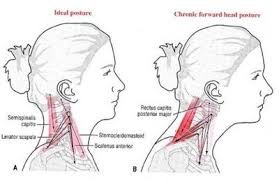Head Over Heels
Restoring Head, Neck & Shoulder Alignment for Posture, Breath & Improved Mechanics
Introduction: Why Your Upper Body Alignment Matters
A few years ago, I started working with a retired special education teacher who had spent decades hunched over desks, grading papers, and caring for students. Like many people, she hadn't thought much about her posture or movement habits—until pain forced her to.
Years of sitting, stress, and lack of movement had taken their toll. She had developed a pronounced Dowager’s hump, Forward Head Posture (FHP), and chronic shoulder pain. Over time, these imbalances cascaded down through her spine and pelvis, increasing pressure on her lower back. Eventually, the strain became so severe that she required spinal fusion surgery—which is what ultimately led her to me.
By the time we started working together, she felt stiff, weak, and disconnected from her body. She assumed that at her age, it was too late to reverse these patterns—that her posture, discomfort, and limited mobility were just things she would have to live with.
But what she didn’t realize was that even after surgery, her body was still adaptable. Through breath training, postural realignment, and deep stabilizer activation, we worked to restore mobility in her rib cage, retrain her shoulder girdle, and improve the way she carried her head and neck.
Over time, her pain decreased, her posture improved, and she regained movement she thought was lost forever. By addressing the underlying mechanics of her discomfort—rather than just reacting to symptoms—she was able to make meaningful changes in both her pain levels and movement patterns.
Her story is not unique. Many people come in later in life trying to unwind years of habits and patterns. While preventative care is always the best medicine, the body remains adaptable for as long as we are alive. This means that the sooner we begin restoring functional alignment and improving movement habits, the better our long-term outcomes will be
Neck tension, tight shoulders, and restricted breathing are among the most common physical issues today. Whether due to long hours at a desk, frequent phone use, stress, or improper training habits, many of us unknowingly carry chronic tension and misalignment in this region.
These imbalances don’t just create discomfort; they can have profound effects on spinal health, breathing efficiency, movement coordination, and nervous system regulation.
By understanding the biomechanics of the upper body and learning to restore functional mobility, we can unlock better posture, deeper breath, and more easeful movement throughout the body.
The Weight of the Head: Why Posture Matters
The human head weighs 10-12 lbs—about the size of a bowling ball. When properly aligned, the skeletal structure efficiently supports this weight with minimal muscular effort.
However, modern habits—like staring at screens or slouching—often lead to Forward Head Posture (FHP), where the head drifts forward past the spine. This small shift significantly increases the load on the neck and upper back.
For every inch the head moves forward, the pressure on the spine increases by 10 lbs.
A 3-inch forward head posture can place 40 lbs of force on the cervical spine.
This excessive strain can lead to:
Chronic Neck & Shoulder Tension – Overworked muscles constantly struggle to hold up the head.
Headaches & Jaw Pain – Misalignment contributes to tension headaches and TMJ dysfunction.
Restricted Breathing – A forward head position compresses the diaphragm and ribcage, reducing lung capacity.
Postural Compensations – The spine, pelvis, and even feet adjust to counterbalance a misaligned head.
Nervous System Dysregulation – Chronic tension in this area impacts the vagus nerve, influencing stress responses
Breath, Posture & Shoulder Function: The Interplay
One of the most overlooked consequences of poor head and shoulder alignment is its impact on breathing.
When the head juts forward, the rib cage loses mobility, making it difficult for the diaphragm to fully expand. Instead of deep, efficient breathing, people resort to shallow chest breathing, reinforcing tension patterns in the upper body.
Physical therapist Uwe Horvath has developed an approach to shoulder organization and breath mechanics, focusing on how breath directly influences stability and movement efficiency. His method emphasizes:
Training the body to take deep belly breaths instead of shallow chest breathing, which creates excess tension in the neck and chest.
Activating the posterior deep stabilizers of the shoulder girdle to improve support and alignment.
Releasing restrictions in the diaphragm and ribcage to allow for more efficient movement.
When breathing mechanics improve, so does postural integrity, shoulder function, and movement coordination.
What Healthy Head, Neck & Shoulder Mechanics Look Like
A well-aligned head, neck, and shoulder girdle allows for:
A neutral head position—stacked over the spine with minimal effort.
Shoulders that move freely without excessive bracing or gripping.
A mobile rib cage that expands fully with breath.
A responsive spine that supports fluid movement.
When postural integrity is restored, we move with less strain, greater efficiency, and improved longevity.
The Hidden Costs of Poor Upper Body Alignment
Beyond just tension and stiffness, prolonged misalignment in the head, neck, and shoulders can contribute to:
Chronic Pain & Mobility Restrictions
Poor alignment overloads the cervical spine and shoulders, leading to degenerative changes over time.
Studies show that Forward Head Posture (FHP) is associated with higher rates of neck pain, headaches, and even dizziness.
Decreased Athletic Performance & Injury Risk
Shoulder dysfunction from poor posture can lead to a limited range of motion in pressing, hanging, and throwing mechanics.
Ribcage immobility restricts full breathing, decreasing endurance and force production.
Nervous System & Stress Responses
Chronic tension in the neck and shoulders impacts the vagus nerve, which regulates relaxation and digestion.
Poor breathing mechanics increase sympathetic (fight-or-flight) activation, making it harder to recover from stress.
Practical Steps to Improve Head, Neck & Shoulder Alignment
Making small daily changes can dramatically improve your posture, relieve tension, and support more coordinated movement.
Rebalance Your Posture
Align your ears over your shoulders when sitting or standing.
Keep screens at eye level to reduce forward head posture.
Restore Breathing Mechanics (Inspired by Uwe Horvath’s Method)
Practice belly breathing—inhale deeply through the nose, expanding the belly instead of the chest.
Use breath awareness drills to improve ribcage mobility and diaphragm function.
Mobilize & Strengthen the Upper Body
Thoracic Spine Mobility – Use side lying rotations and backbends to free up movement in the mid and upper back.
Shoulder Controlled Articular Rotations (CARs) - help restore the full range of motion.
Hanging & Overhead Work – Gradually reintroduce overhead movements to build balanced strength.
Strengthen the deep stabilizing muscles of the front of the neck
Release Chronic Tension
Self-massage the neck, traps, and jaw to reduce built-up stiffness.
Use soft tissue work on the small muscles of the occipital region to open the back of the neck
The Bigger Picture: Moving Toward a More Resilient Body
The alignment of your head, neck, and shoulders influences how you move, breathe, and function every day.
By addressing imbalances and integrating mindful movement, you can:
Reduce pain and tension
Improve postural awareness
Restore breath efficiency
Increase movement capacity
Enhance nervous system regulation
Your posture, breath, and movement potential are deeply connected. Taking the time to recalibrate your alignment is an investment in your long-term mobility, strength, and well-being.





